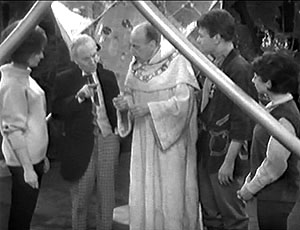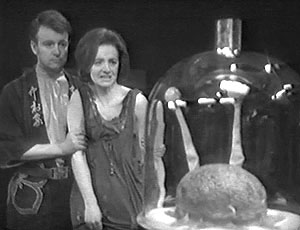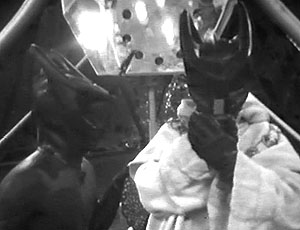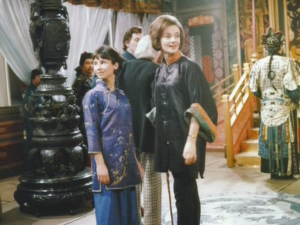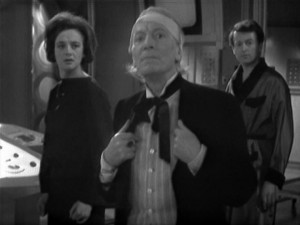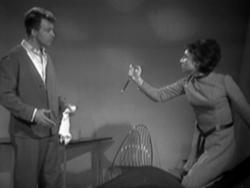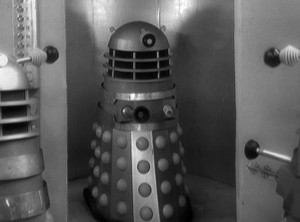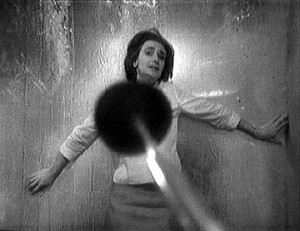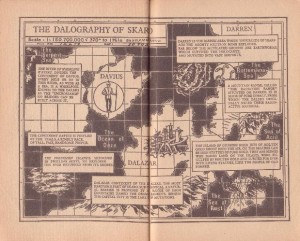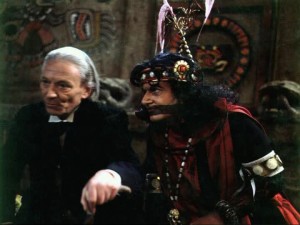 The mighty Aztec civilization is at the height of its power, but its future hangs in the balance when the Doctor and his companions arrive. This story lets us glimpse the glory of the Aztecs–and their bloodthirsty practice of human sacrifice. Companion Barbara takes on the role of goddess and prophetess and is determined to save the Aztecs from their eventual destruction by ending human sacrifice. Will time be rewritten? And how does the Doctor’s first-ever on screen romance play out?
The mighty Aztec civilization is at the height of its power, but its future hangs in the balance when the Doctor and his companions arrive. This story lets us glimpse the glory of the Aztecs–and their bloodthirsty practice of human sacrifice. Companion Barbara takes on the role of goddess and prophetess and is determined to save the Aztecs from their eventual destruction by ending human sacrifice. Will time be rewritten? And how does the Doctor’s first-ever on screen romance play out?
* * *
This four-part episode originally aired between May 23 and June 13, 1964.
It is a startling good story. I was really surprised. When I started watching Doctor Who from the beginning, I was dreading the historical stories, which I assumed would be among the most boring—particularly after the caveman story in An Unearthly Child. However, Marco Polo made me reconsider this assumption when it turned out to be surprisingly good.
This story is even better. It is better than the futuristic stories that come before it–better than The Daleks, The Edge of Destruction, and The Keys of Marinus. It is, quite simply, the best Doctor Whostory thus far.
It’s Against BBC Programming to Impersonate a Deity?
The TARDIS has landed in southern Mexico in the late 1400s, during the height of the Aztec civilization, before the arrival of the Europeans and the conquest of Cortez. Specifically, the TARDIS has landed inside the sealed tomb of an ancient Aztec high priest that has come to be regarded as a god.
The tomb is at the top of an Aztec pyramid, and it doubles as a temple. Budgetary limitations prevent them showing us the pyramid in long shot, but it is made clear to the audience that they are at the top of one.
The Aztecs mistake Barbara as the reincarnation of the high priest/deity (the fact he was male is not relevant, she explains, since the soul was regarded as being able to reincarnate as either gender). The Doctor, Ian, and Susan are then regarded as her servants.
Rather than correct them, Barbara embraces the role, with the Doctor’s encouragement, as it will allow them to figure out a way back into the sealed tomb so that they can regain the TARDIS and leave.
It quickly becomes clear that two of the main players in Aztec society are the thoughtful “high priest of knowledge” and the bloodthirsty “high priest of sacrifice.”
Giving Everyone Something to Do
This episodes gives each of the regulars something notable to do:
- Although Barbara, as a presumed goddess, remains largely in the temple, her “servants” are taken elsewhere.
- The Doctor is allowed to wander the city, and he is taken to a group of senior citizens, where he meets and becomes romantically involved with an Aztec wise woman—his first-ever on screen romance!
- Ian is appointed the leader of the Aztecs’ army, which puts him in contention with the current leader, who is named Ixta.
- Susan, after unwittingly violating an Aztec law, is placed in a ladies’ seminary (i.e., school) to learn the ways of the Aztecs. She proves a good student, but it will turn out that there is a limit to how far she is willing to go in honoring Aztec customs.
Human Sacrifice!
Matters heat up when Ian discovers that—in order to end the current drought—he will be expected to participate in a human sacrifice and must bring the victim to the site of the sacrifice and then hold him down as he is killed.
When Ian tells the Doctor about this, the Doctor shockingly tells him to play his part and not to make trouble. They can’t change anything, the Doctor explains, and they need to keep a low profile in order to escape.
When the Doctor tells the same thing to Barbara, who is expected to witness the sacrifice in her capacity as a goddess, she refuses.
At the beginning of the story, she lectured Susan about how the Spanish were so horrified by Aztec culture that they utterly destroyed it—both the good and the bad.
Now she says that she wants to use her role as a goddess to end human sacrifice and make their culture less horrifying so that it won’t be completely destroyed.
Rewriting History?
The Doctor tells her that she can’t re-write history—“not one line” (a phrase that River Song will use, much later, in Forest of the Dead). Whether he means that re-writing time is impossible or something that must not be done is ambiguous, and it remains so.
Matters begin to build to a head, and the time for the drought-ending human sacrifice approaches. Ian and his rival escort the victim to the temple, who lies on an altar stone. In keeping with the Doctor’s instructions, Ian holds down the victim’s legs(!).
Barbara then rejects the Doctor’s counsel and orders an end to the sacrifice.
Everyone is shocked—including the victim! He leaps up and declares that Barbara has denied him honor.
The high priest of sacrifice whispers that he should “honor us with your death,” and the victim leaps up on a stone block and then hurls himself off the pyramid—making this the second on screen suicide in Doctor Who (after the suicide of Tegana in Marco Polo).
The Aztec Empire Strikes Back
Barbara’s actions have endangered the whole group, because the high priest of sacrifice becomes convinced that Barbara is not really a divine reincarnation but rather a false goddess.
We thus have the main elements of conflict on the table:
- How will the characters deal with the danger they are put in by the high priest of sacrifice?
- How do they get back to the TARDIS and escape?
- What effect do Barbara’s efforts have on Aztec culture?
Ian takes the lead in dealing with the danger, which frequently takes the form of his rivalry with the other military commander. The high priest of sacrifice engineers a conflict between the two, promising the commander wealth and glory if he kills Ian.
Ian turns out to be surprisingly good at physical combat, including hand-to-hand combat. At one point, he uses surprise to disable his opponent with his thumb (apparently by applying pressure to the carotid artery and causing him to black out), much to the amazement of the Aztecs.
The Doctor, meanwhile, tries to figure out how to get back into the tomb where the TARDIS is. The wise woman Cameca, with whom he has a budding romance, tells him about the man who built the temple. The man has vanished, but his son is still around and may have knowledge of how to get in.
Plot Collision!
These two plots intersect when it turns out that the architect’s son is, in fact, Ian’s military rival. Not realizing this, the Doctor gives the rival a needle with a plant-based drug that will cause unconsciousness, and he uses it to disable Ian in combat.
Though the combat is not supposed to be to the death, the high priest of sacrifice urges the rival to kill Ian, and he is about to do so when Barbara suddenly appears—having left the temple—and invokes her authority as a goddess, telling him to stop.
The high priest of sacrifice tells her, if she is a goddess, to save her servant, and she instantly puts a knife to the throat of the priest and says she will kill him if he doesn’t have the rival back off. Go Barbara!
Danger re-appears when the high priest of sacrifice has a poison prepared and he offers it to Barbara, in reconciliation, as a friendship drink. Ian realizes that it’s poison and waves Barbara off. She then insists that the priest drink first, and when he refuses she dramatically smashes the cup and condemns the priest for trying to test his goddess.
Just a Nice Cup of Cocoa
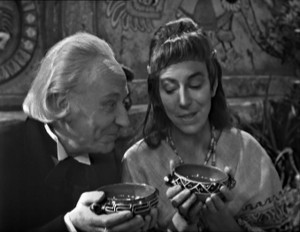 Another drink of friendship—a genuine one—occurs when Cameca shows up with cocoa beans, and the Doctor makes the two of them cocoa to drink together.
Another drink of friendship—a genuine one—occurs when Cameca shows up with cocoa beans, and the Doctor makes the two of them cocoa to drink together.
He knows this is an Aztec courting ritual, and he admits it when Cameca says that he has declared his love for her.
What he does not realize is that drinking cocoa with a woman isn’t just a declaration of love. It’s a commitment to marry, and the Doctor has just become engaged!
(Y’know, this Aztec wise woman looks like an older River Song, so there’s a potential retcon here.)
Double Wedding?
Marriage also seems on the horizon for Susan.
It turns out that there is an eclipse coming up, and there’s going to be another human sacrifice to make the sun reappear.
The intended victim of this sacrifice gets whatever he wants in the few remaining days he has, and through the machinations of the high priest of sacrifice, he goes to the lady’s seminary and asks for Susan in marriage.
Given that she is “one little maid” in a ladies’ “seminary” who is to marry a man willing to be executed in a few days time, it’s hard not to see this as an homage to The Mikado, and—given the popularity of Gilbert and Sullivan at the time—it’s hard not to think that the adults in the audience were meant to recognize it as such.
Susan, however, absolutely refuses, which is a major breach of Aztec protocol, and she is to be punished by having thorns stuck into her.
Escape!
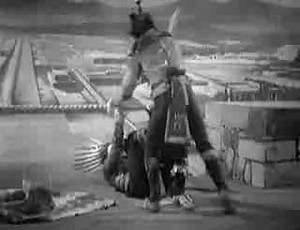 Ian and the Doctor eventually engineer a way back into the tomb where the TARDIS is, and they don’t do it by simply finding a hidden button they can press.
Ian and the Doctor eventually engineer a way back into the tomb where the TARDIS is, and they don’t do it by simply finding a hidden button they can press.
Instead, they build a pulley that they can use to winch the door open. This involves a bit of work since the Aztecs don’t have the wheel, and the doctor has to construct the pulley himself.
As he does so, Cameca realizes that she is going to lose him, and at first she seems resigned to this fate.
When the moment arrives, however, she asks to go with the Doctor. He refuses to take her, and she poignantly tells him to remember her.
Before the crew can get back in the TARDIS, Ian is attacked one last time by his rival, and the two of them have a fight in Aztec warrior gear at the top of the temple. It ends when Ian hurls his rival off the top of the pyramid.
Meanwhile, the eclipse is happening, and the high priest of sacrifice is determined to off the intended victim—seemingly in the knowledge that the sun will reappear even if he doesn’t—so the act appears to be one of preserving his power and the existing order of things.
The victim is quickly laid on the altar, and we see the priest raising the dagger and preparing to strike when we suddenly cut away.
Did She Make a Difference?
Back in the tomb, Barbara is very disappointed that she was unable to rewrite history, and so the Aztec civilization will be destroyed—its good points along with its bad ones—when Cortez arrives.
The Doctor points out, however, that she did make a difference.
While the high priest of sacrifice was the main villain of this story, he had a rival who I haven’t discussed much up to know—the high priest of knowledge.
This man is portrayed as an older, wiser figure than the high priest of sacrifice (who is just bloodthirsty). When we first meet him, he is already having doubts about the necessity of human sacrifice, making him a natural ally of Barbara.
There is also a nice scene in which Ian tells Barbara that she’s looking at Aztec culture through rose colored glasses—that the high priest of knowledge is the odd man out here and that the majority of the population is in sympathy with the high priest of sacrifice.
The high priest of knowledge places his faith in Barbara as a goddess and is willing to undertake personal risk for her, but then his faith in her—and in Aztec customs in general—is shattered. He ends up leaving the city to live alone in the forest.
Barbara sees this as another failure on her part. Not only has she failed to stop human sacrifice, she cost an old man his faith.
The Doctor, however, tells her that the man found a new and better faith, and thus while they didn’t change the course of history, they did help one man.
It is not at all clear that the high priest of knowledge has found a new faith. For all we can tell, he leaves the episode an agnostic.
(On a happier note, in the bonus features they mention that the actor playing this character spent the last 10-20 years of his life as a very devout Catholic and is now buried in a cemetery alongside a number of monks.)
Despite the fact that this character’s fate may not be as rosy as the Doctor indicates, the Doctor’s speech points to what will become a major trope in the Doctor Who episodes set in the known past: The show won’t be changing the known course of history, but the Doctor and his team may be able to help individual people.
Final Evaluation
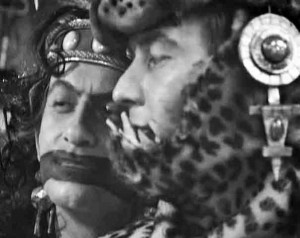 I was very surprised by how good this story was. It is, frankly, the best of theDoctor Who stories thus far.
I was very surprised by how good this story was. It is, frankly, the best of theDoctor Who stories thus far.
The plot is vigorous, and the Aztec costumes, sets, and artifacts are exotic and interesting to look at. It’s a pity that it was broadcast in black and white and we only have still images in color.
There is also a substantial amount of humor. I particularly like a scene in which Ian’s rival is telling Susan that he has killed Ian, and at that very moment Ian’s face appears in the background, revealing that he is not dead.
The story also tackles two major issues—the malleability of time and human sacrifice.
It doesn’t ultimately resolve whether or to what extent time can be changed, but this is an important question for a time travel show, and the presence of human sacrifice in the story gives the question special intensity.
One thing that is clear is that the Doctor’s conscience isn’t yet fully formed:
- In The Daleks, he was too willing to use the Thals as canon fodder to help the group escape.
- InThe Keys of Marinus, he was willing to help rebuild a planetary mind control device, though he eventually expressed a preference for men having free will.
- And in this episode, although he doesn’t approve of human sacrifice, he’s too willing to go along with it. He could express way more regret than he does about the fact that they won’t be able to change Aztec culture on this point. In particular, it’s hard to imagine any future Doctor telling Ian to play his part in the ritual and hold the legs of the victim.
The Doctor is thus not a fully formed character—he’s still developing into the Doctor as we will come to know him.
RATING: * * * 1/2
WATCH THIS STORY YOURSELF:
